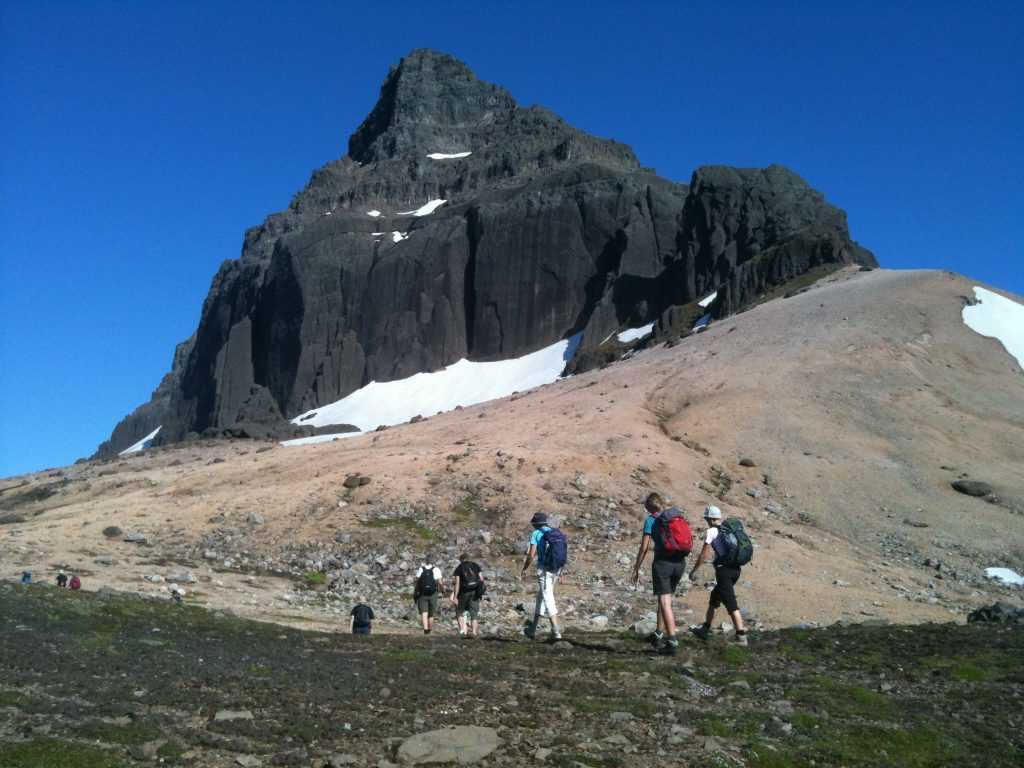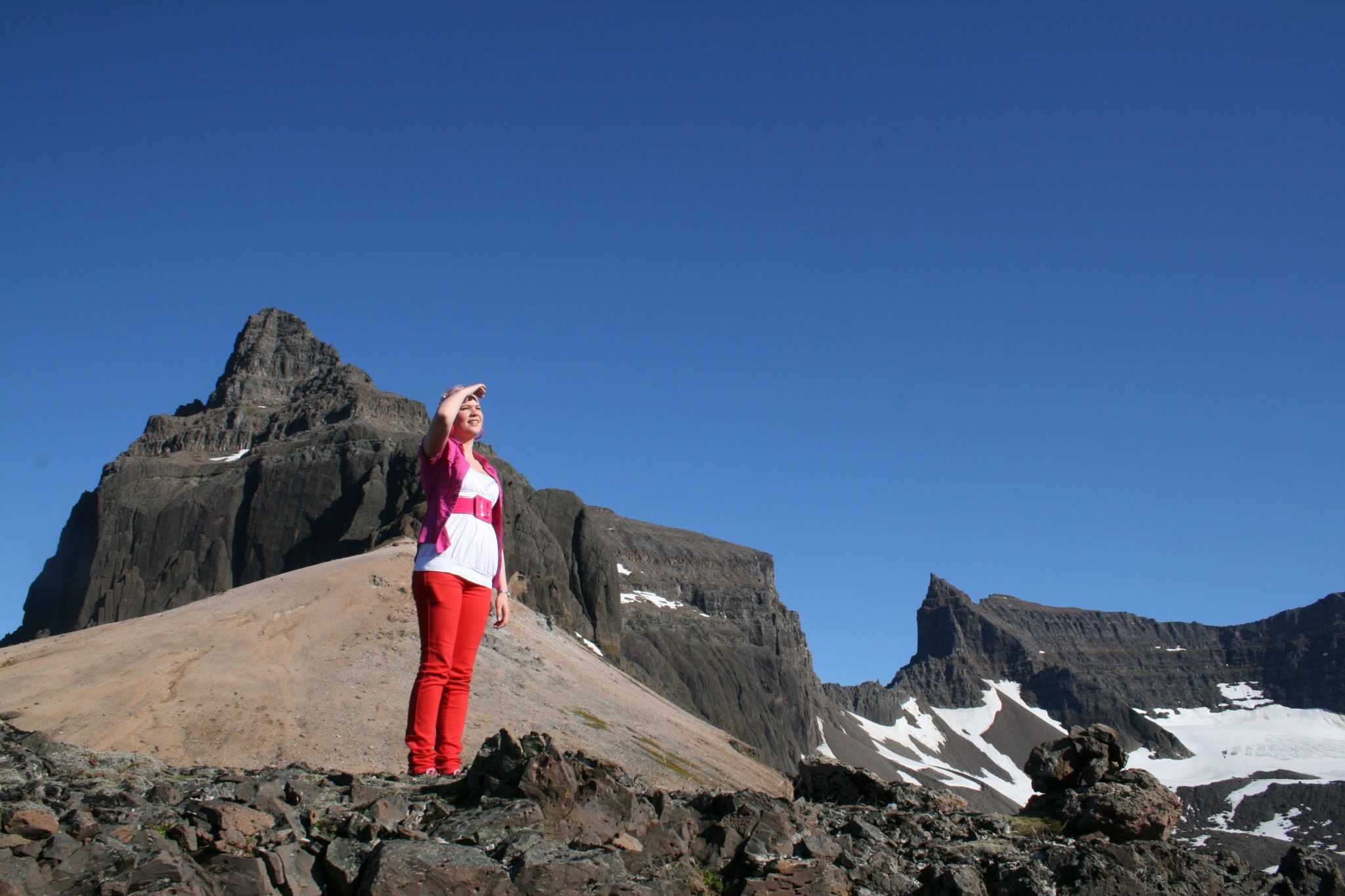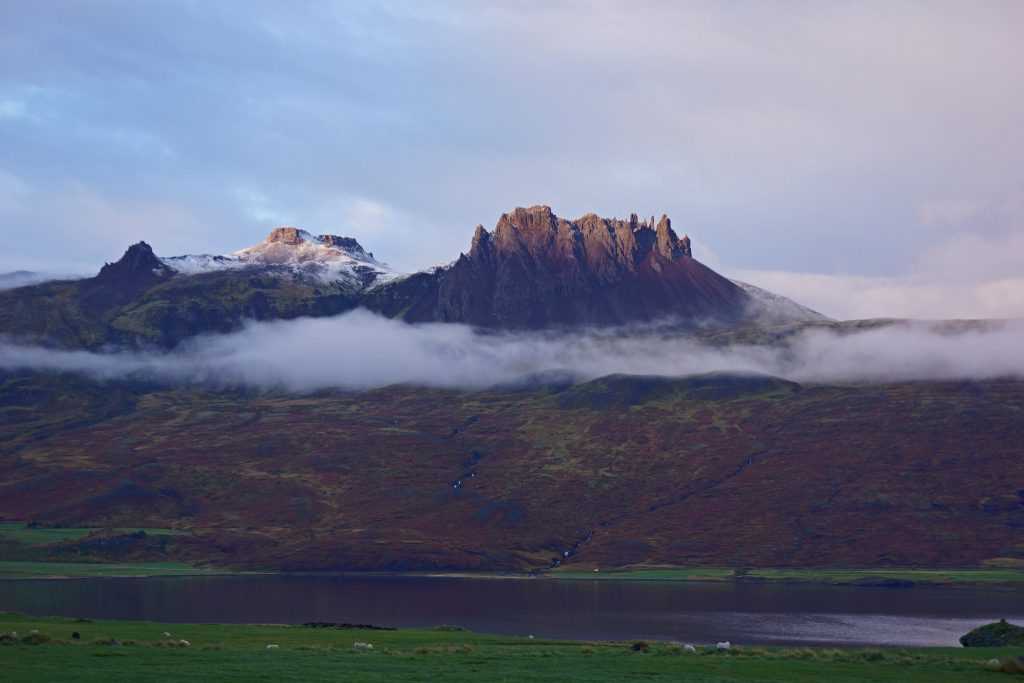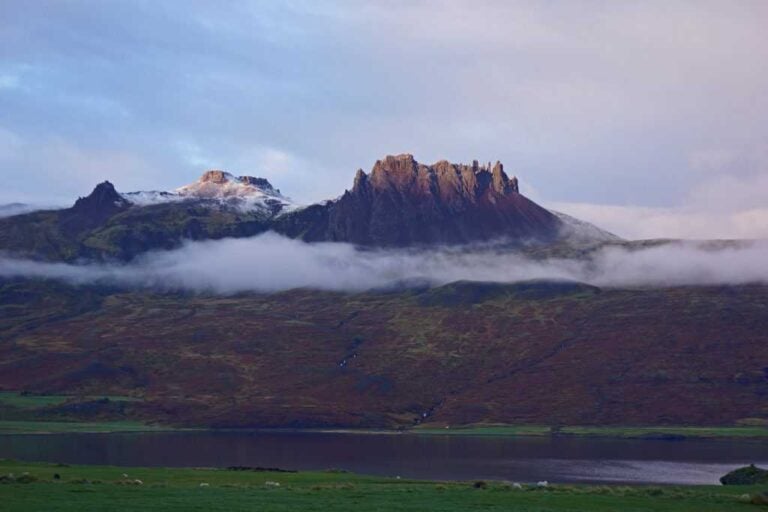Borghildur of Alfaborg
Borgarfjörður is one of the most picturesque places in Iceland. Between Njarðvík and Loðmundarfjörður, it is the northernmost of the fjords that cut into the highlands of the East Fjords. About 4 km across and 5 km long, Borgarfjörður stretches from Landsendi in the north to Hafnartangi in the south. In recent times, a village named Bakkagerði has grown up at the head of the fjord. Offshore to the east of the fjord is a small island named Hafnarhólmi, which abounds in seabirds during the nesting season. A harbour wall was built from the shore out to the island, thus providing Borgarfjörður seamen with good shelter for their boats. From the shore, a wide, grassy valley stretches inland, dotted with farms. The valley is surrounded by varied and colourful mountains, where dark basalt and pale rhyolite come together in spectacular rock formations. At the head of the valley the Dyrfjöll mountains rise up, dark and impressive, to more than 1,100m above sea level. In the lowlands at the village of Bakkagerði stands a rocky hill known as Borg or Alfaborg (Elf Rock). This attractive feature has long been believed to be one of the main centres of Iceland’s elf population. Over the years many people have seen these graceful beings. In olden times the elves were believed to attend church in Kœkjudalur, a narrow valley inland from Borgarfjörður; in the valley stands a huge rock shaped like a building, which is called Kirkjusteinn (Church Rock). Elves were sometimes seen riding in company to the church in Kœkjudalur.
 The people of Borgarfjörður eystri live by fishing and fish processing, as well as agriculture. In Bakkagerði there is also a business called Álfasteinn, where rocks and stones are polished to make jewellery and souvenirs. There is considerable demand for these items, especially as a growing number of visitors make their way to the Borgarfjörður area. The mountains around the fjord are also rich in interesting and attractive stones.
The people of Borgarfjörður eystri live by fishing and fish processing, as well as agriculture. In Bakkagerði there is also a business called Álfasteinn, where rocks and stones are polished to make jewellery and souvenirs. There is considerable demand for these items, especially as a growing number of visitors make their way to the Borgarfjörður area. The mountains around the fjord are also rich in interesting and attractive stones.
 The village of Bakkagerði has a church, school, shop, community centre and so on. In former times the Borgarfjörður parish church stood at Desjarmýri, farther inland, where the pastor resided, but in the early 1900s the church was transported down to Bakkagerði, where the pastor also settled. The church, which is close to Alfaborg, contains an interesting altarpiece painted by Johannes Sveinsson Kjarval (1885—1972), one of Iceland’s leading 20th-century artists. The altarpiece depicts the Sermon on the Mount; Christ stands upon Alfaborg, with the Dyrfjöll mountains in the background. The altar-piece was controversial when painted, as some deemed it too “worldly” for a church. Though bom in the south of Iceland, Kjarval grew up on the farm of Geitavik in Borgarfjörður, and the surroundings of his youth played an important part in his art. And it is possible that the mystical elements of his art reflect the influence of stories of elves and other supernatural creatures that he heard when he was young.
The village of Bakkagerði has a church, school, shop, community centre and so on. In former times the Borgarfjörður parish church stood at Desjarmýri, farther inland, where the pastor resided, but in the early 1900s the church was transported down to Bakkagerði, where the pastor also settled. The church, which is close to Alfaborg, contains an interesting altarpiece painted by Johannes Sveinsson Kjarval (1885—1972), one of Iceland’s leading 20th-century artists. The altarpiece depicts the Sermon on the Mount; Christ stands upon Alfaborg, with the Dyrfjöll mountains in the background. The altar-piece was controversial when painted, as some deemed it too “worldly” for a church. Though bom in the south of Iceland, Kjarval grew up on the farm of Geitavik in Borgarfjörður, and the surroundings of his youth played an important part in his art. And it is possible that the mystical elements of his art reflect the influence of stories of elves and other supernatural creatures that he heard when he was young.
 Borgarfjörður eystri is generally acknowledged to be one of the most beautiful regions in Iceland and it is also famed for its rich heritage of folklore; the Borgarfjörður tales of elves or “hidden folk” are unusually imaginative. For example:
Borgarfjörður eystri is generally acknowledged to be one of the most beautiful regions in Iceland and it is also famed for its rich heritage of folklore; the Borgarfjörður tales of elves or “hidden folk” are unusually imaginative. For example:
Once upon a time a farmer lived at Jökulsá, which is the closest farm to Alfaborg west of the Fjarðará river. He had a maidservant whose name was Guðrún. One Sunday in summer the entire household went to church at Desjarmýri, except the maidservant Guðrún. Her mistress asked her to round up the sheep and milk the ewes. Then she was to skim the milk and churn the butter. The household went off to church and the girl set off to round up the sheep. When she had milked the ewes, she let them out on to the gravel banks below the farm. Then she started to cook dinner and when she had finished her work she went outside to look out for the ewes and take a look around. She saw many people riding along the path below the homefield. They were wearing brightly coloured clothing and rode fine, spirited horses. She was most astonished, for everybody should have left for church earlier. All these people rode by the farm, except for one woman who rode up the homefield to the farmhouse.
 The woman was quite elderly, but looked well and had a noble countenance. She greeted the girl and said: “Give me some buttermilk to drink, my girl.” Guðrún ran indoors, filled a wooden jug with buttermilk and brought it out to her, and the woman took the jug and drank. When she looked up from the jug, the girl asked: “What is your name?” The woman did not reply, but drank again. The maidservant then asked the same question again. When the woman had drunk from the jug and replaced the lid, the girl saw that she reached into her bodice, took a beautiful linen cloth, placed it over the jug lid and passed it to her as she thanked her. Then the girl asked a third time: “What is your name?” “My name is Borghildur, Miss Curiosity,” said the woman as she spurred her horse and rode away from the farm to follow the rest. Guðrún the maidservant watched them; the last thing she saw was that they disappeared behind a grey rock at Kollutungur, which leads to Kækjudalur.
The woman was quite elderly, but looked well and had a noble countenance. She greeted the girl and said: “Give me some buttermilk to drink, my girl.” Guðrún ran indoors, filled a wooden jug with buttermilk and brought it out to her, and the woman took the jug and drank. When she looked up from the jug, the girl asked: “What is your name?” The woman did not reply, but drank again. The maidservant then asked the same question again. When the woman had drunk from the jug and replaced the lid, the girl saw that she reached into her bodice, took a beautiful linen cloth, placed it over the jug lid and passed it to her as she thanked her. Then the girl asked a third time: “What is your name?” “My name is Borghildur, Miss Curiosity,” said the woman as she spurred her horse and rode away from the farm to follow the rest. Guðrún the maidservant watched them; the last thing she saw was that they disappeared behind a grey rock at Kollutungur, which leads to Kækjudalur.
After a long time the people of the household returned from church in the evening. The girl then told them what had happened during the day and showed them the cloth the woman had given her. It was so beautiful that nobody had ever seen such a fine cloth. It is said to have been passed down among Icelandic gentlewomen through the ages. The riders seen by the maidservant were believed to have been elves from Alfaborg, on their way to church in Kækjudalur.


